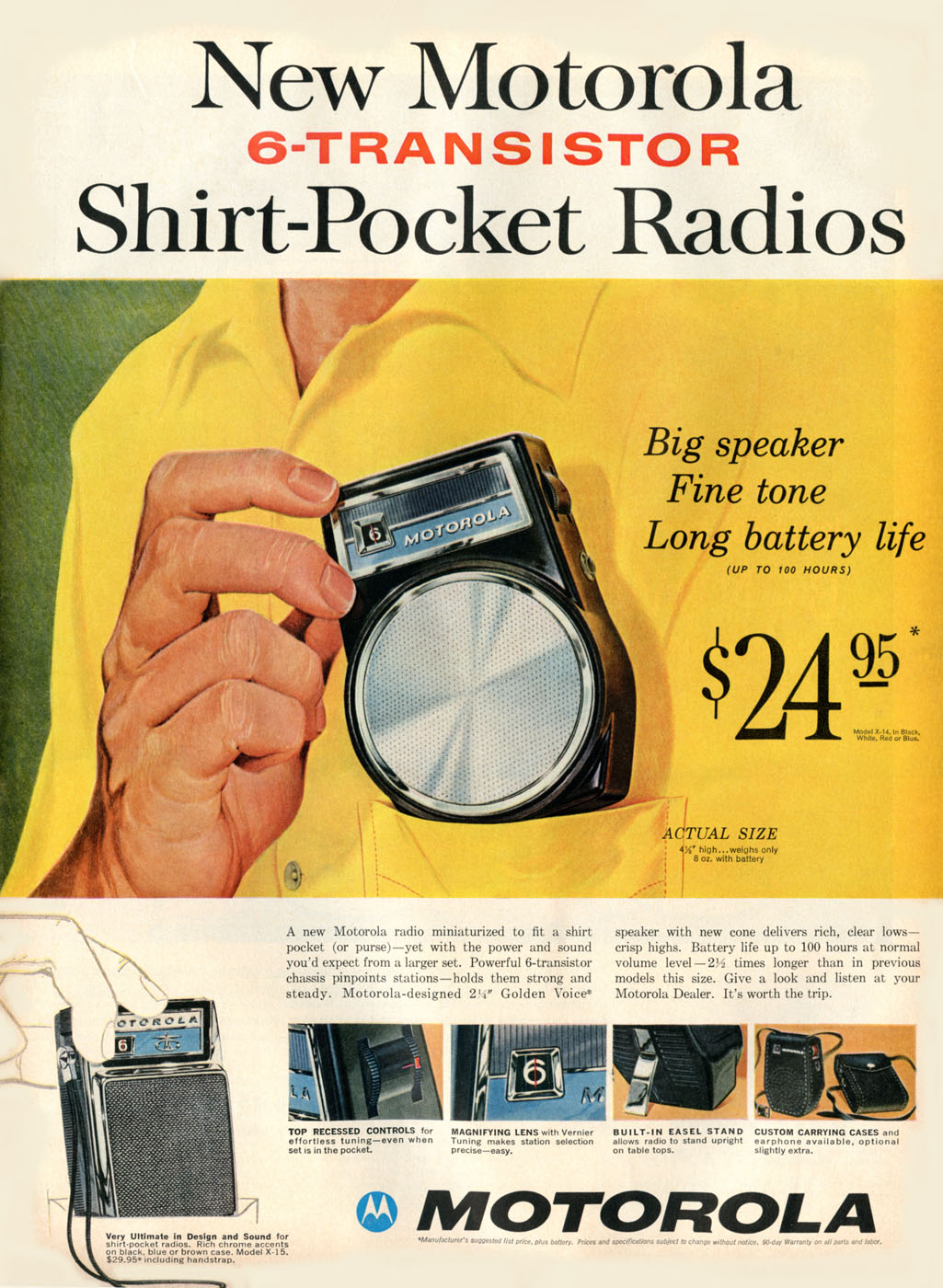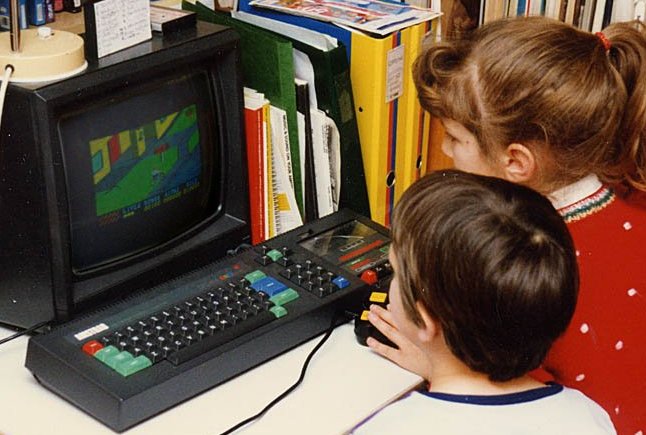|
8-bit
In computer architecture, 8-bit integers or other data units are those that are 8 bits wide (1 octet). Also, 8-bit central processing unit (CPU) and arithmetic logic unit (ALU) architectures are those that are based on registers or data buses of that size. Memory addresses (and thus address buses) for 8-bit CPUs are generally larger than 8-bit, usually 16-bit. 8-bit microcomputers are microcomputers that use 8-bit microprocessors. The term '8-bit' is also applied to the character sets that could be used on computers with 8-bit bytes, the best known being various forms of extended ASCII, including the ISO/IEC 8859 series of national character sets especially Latin 1 for English and Western European languages. The IBM System/360 introduced byte-addressable memory with 8-bit bytes, as opposed to bit-addressable or decimal digit-addressable or word-addressable memory, although its general-purpose registers were 32 bits wide, and addresses were contained in the lower 24 bits ... [...More Info...] [...Related Items...] OR: [Wikipedia] [Google] [Baidu] |
Zilog Z80
The Zilog Z80 is an 8-bit computing, 8-bit microprocessor designed by Zilog that played an important role in the evolution of early personal computing. Launched in 1976, it was designed to be Backward compatibility, software-compatible with the Intel 8080, offering a compelling alternative due to its better Integrated circuit, integration and increased performance. Along with the 8080's seven Processor register, registers and flags register, the Z80 introduced an alternate register set, two 16-bit index registers, and additional instructions, including bit manipulation and block copy/search. Originally intended for use in embedded systems like the 8080, the Z80's combination of compatibility, affordability, and superior performance led to widespread adoption in video game systems and home computers throughout the late 1970s and early 1980s, helping to fuel the personal computing revolution. The Z80 was used in iconic products such as the Osborne 1, TRS-80, Radio Shack TRS-80, Col ... [...More Info...] [...Related Items...] OR: [Wikipedia] [Google] [Baidu] |
MOS Technology 6502
The MOS Technology 6502 (typically pronounced "sixty-five-oh-two" or "six-five-oh-two") William Mensch and the moderator both pronounce the 6502 microprocessor as ''"sixty-five-oh-two"''. is an 8-bit computing, 8-bit microprocessor that was designed by a small team led by Chuck Peddle for MOS Technology. The design team had formerly worked at Motorola on the Motorola 6800 project; the 6502 is essentially a simplified, less expensive and faster version of that design. When it was introduced in 1975, the 6502 was the least expensive microprocessor on the market by a considerable margin. It initially sold for less than one-sixth the cost of competing designs from larger companies, such as the 6800 or Intel 8080. Its introduction caused rapid decreases in pricing across the entire processor market. Along with the Zilog Z80, it sparked a series of projects that resulted in the home computer microcomputer revolution, revolution of the early 1980s. Home video game consoles and home com ... [...More Info...] [...Related Items...] OR: [Wikipedia] [Google] [Baidu] |
Microcontroller
A microcontroller (MC, uC, or μC) or microcontroller unit (MCU) is a small computer on a single integrated circuit. A microcontroller contains one or more CPUs (processor cores) along with memory and programmable input/output peripherals. Program memory in the form of NOR flash, OTP ROM, or ferroelectric RAM is also often included on the chip, as well as a small amount of RAM. Microcontrollers are designed for embedded applications, in contrast to the microprocessors used in personal computers or other general-purpose applications consisting of various discrete chips. In modern terminology, a microcontroller is similar to, but less sophisticated than, a system on a chip (SoC). A SoC may include a microcontroller as one of its components but usually integrates it with advanced peripherals like a graphics processing unit (GPU), a Wi-Fi module, or one or more coprocessors. Microcontrollers are used in automatically controlled products and devices, such as automobile engi ... [...More Info...] [...Related Items...] OR: [Wikipedia] [Google] [Baidu] |
Motorola 6800
The 6800 ("''sixty-eight hundred''") is an 8-bit microprocessor designed and first manufactured by Motorola in 1974. The MC6800 microprocessor was part of the M6800 Microcomputer System (later dubbed ''68xx'') that also included serial and parallel interface ICs, RAM, ROM and other support chips. A significant design feature was that the M6800 family of ICs required only a single five-volt power supply at a time when most other microprocessors required three voltages. The M6800 Microcomputer System was announced in March 1974 and was in full production by the end of that year. "Motorola's M6800 microcomputer system, which can operate from a single 5-volt supply, is moving out of the sampling stage and into full production." The small-quantity price of the MC6800 is . The MC6820 PIA cost . American Microsystems was licensed as the second source. The 6800 has a 16-bit address bus that can directly access of memory and an 8-bit bi-directional data bus. It has 72 instructions with ... [...More Info...] [...Related Items...] OR: [Wikipedia] [Google] [Baidu] |
Home Computer
Home computers were a class of microcomputers that entered the market in 1977 and became common during the 1980s. They were marketed to consumers as affordable and accessible computers that, for the first time, were intended for the use of a single, non-technical user. These computers were a distinct market segment that typically cost much less than business, scientific, or engineering-oriented computers of the time, such as those running CP/M or the IBM PC, and were generally less powerful in terms of computer memory, memory and expandability. However, a home computer often had better video display controller, graphics and sound than contemporary business computers. Their most common uses were word processing, playing video games, and computer programming, programming. Home computers were usually sold already manufactured in stylish metal or plastic enclosures. However, some home computers also came as commercial electronic kits, like the ZX80, Sinclair ZX80, which were both h ... [...More Info...] [...Related Items...] OR: [Wikipedia] [Google] [Baidu] |
Microprocessor
A microprocessor is a computer processor (computing), processor for which the data processing logic and control is included on a single integrated circuit (IC), or a small number of ICs. The microprocessor contains the arithmetic, logic, and control circuitry required to perform the functions of a computer's central processing unit (CPU). The IC is capable of interpreting and executing program instructions and performing arithmetic operations. The microprocessor is a multipurpose, Clock signal, clock-driven, Processor register, register-based, digital integrated circuit that accepts binary code, binary data as input, processes it according to instruction (computing), instructions stored in its computer memory, memory, and provides results (also in binary form) as output. Microprocessors contain both combinational logic and sequential logic, sequential digital logic, and operate on numbers and symbols represented in the binary number system. The integration of a whole CPU on ... [...More Info...] [...Related Items...] OR: [Wikipedia] [Google] [Baidu] |
General-purpose Registers
A processor register is a quickly accessible location available to a computer's processor. Registers usually consist of a small amount of fast storage, although some registers have specific hardware functions, and may be read-only or write-only. In computer architecture, registers are typically addressed by mechanisms other than main memory, but may in some cases be assigned a memory address e.g. DEC PDP-10, ICT 1900. Almost all computers, whether load/store architecture or not, load items of data from a larger memory into registers where they are used for arithmetic operations, bitwise operations, and other operations, and are manipulated or tested by machine instructions. Manipulated items are then often stored back to main memory, either by the same instruction or by a subsequent one. Modern processors use either static or dynamic random-access memory (RAM) as main memory, with the latter usually accessed via one or more cache levels. Processor registers are normally ... [...More Info...] [...Related Items...] OR: [Wikipedia] [Google] [Baidu] |
Intel 8080
The Intel 8080 is Intel's second 8-bit computing, 8-bit microprocessor. Introduced in April 1974, the 8080 was an enhanced successor to the earlier Intel 8008 microprocessor, although without binary compatibility.'' Electronic News'' was a weekly trade newspaper. The same advertisement appeared in the :File:Intel 8080 Advertisement May 1974.jpg, May 2, 1974, issue of ''Electronics'' magazine. Originally intended for use in Embedded system, embedded systems such as calculators, cash registers, computer terminals, and industrial robots, its robust performance soon led to adoption in a broader range of systems, ultimately helping to launch the microcomputer industry. Several key design choices contributed to the 8080’s success. Its 40‑pin package simplified interfacing compared to the 8008’s 18‑pin design, enabling a more efficient data bus. The transition to NMOS logic, NMOS technology provided faster transistor speeds than the 8008's PMOS logic, PMOS while also simplifyin ... [...More Info...] [...Related Items...] OR: [Wikipedia] [Google] [Baidu] |
CP/M
CP/M, originally standing for Control Program/Monitor and later Control Program for Microcomputers, is a mass-market operating system created in 1974 for Intel 8080/Intel 8085, 85-based microcomputers by Gary Kildall of Digital Research, Digital Research, Inc. CP/M is a disk operating system and its purpose is to organize files on a magnetic storage medium, and to load and run programs stored on a disk. Initially confined to single-tasking on 8-bit processors and no more than 64 kilobytes of memory, later versions of CP/M added multi-user variations and were migrated to 16-bit processors. CP/M's core components are the ''Basic Input/Output System'' (BIOS), the ''Basic Disk Operating System'' (BDOS), and the ''Console Command Processor'' (CCP). The BIOS consists of drivers that deal with devices and system hardware. The BDOS implements the file system and provides system services to applications. The CCP is the command-line interpreter and provides some built-in commands. CP ... [...More Info...] [...Related Items...] OR: [Wikipedia] [Google] [Baidu] |
ISO/IEC 8859
ISO/IEC 8859 is a joint International Organization for Standardization, ISO and International Electrotechnical Commission, IEC series of standards for 8-bit character encodings. The series of standards consists of numbered parts, such as ISO/IEC 8859-1, ISO/IEC 8859-2, etc. There are 15 parts, excluding the abandoned ISO/IEC 8859-12. The ISO working group maintaining this series of standards has been disbanded. ISO/IEC 8859 parts 1, 2, 3, and 4 were originally Ecma International standard ECMA-94. Introduction While the bit patterns of the 95 graphic character, printable ASCII characters are sufficient to exchange information in modern English language, English, most other languages that use Latin script, Latin alphabets need additional symbols not covered by ASCII. ISO/IEC 8859 sought to remedy this problem by utilizing the eighth bit in an 8-bit byte to allow positions for another 96 printable characters. Early encodings were limited to 7 bits because of restrictions of som ... [...More Info...] [...Related Items...] OR: [Wikipedia] [Google] [Baidu] |
ISO/IEC 8859-1
ISO/IEC 8859-1:1998, ''Information technology—8-bit single-byte coded graphic character sets—Part 1: Latin alphabet No. 1'', is part of the ISO/IEC 8859 series of ASCII-based standard character encodings, first edition published in 1987. ISO/IEC 8859-1 encodes what it refers to as "Latin alphabet no. 1", consisting of 191 characters from the Latin script. This character-encoding scheme is used throughout the Americas, Western Europe, Oceania, and much of Africa. It is the basis for some popular 8-bit character sets and the first two blocks of characters in Unicode. , 1.1% of all web sites use . It is the most declared single-byte character encoding, but as Web browsers and the HTML5 standard interpret them as the superset Windows-1252, these documents may include characters from that set. Some countries or languages show a higher usage than the global average, in 2025 Brazil according to website use, use is at 2.9%, and in Germany at 2.3%. ISO-8859-1 was (ac ... [...More Info...] [...Related Items...] OR: [Wikipedia] [Google] [Baidu] |






